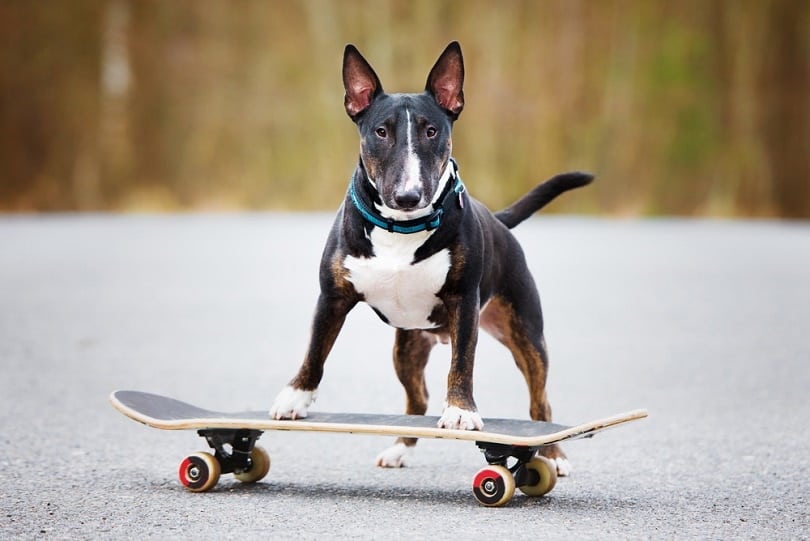WDT_AcD118.jpg)
Like many types of Terriers, the Border Terrier is extremely skilled at hunting small game!
The Bull Terrier is a terrier breed developed in England in the 1800’s. It was developed from crosses that included the New English Bulldog, the Spanish Pointer, and a couple of types of terriers, the English White Terrier and the Staffordshire Terrier. The resulting breed was used as a fighter, and then later on as a guard dog, herder, and rat hunter. A half sized variation of this breed is the Miniature Bull Terrier.
Today’s English Bull Terrier is gentle, fun-loving and courageous. It needs lots of human companionship, and loves to give and receive affection. This breed makes a wonderful pet for active and attentive families. The Bull Terrier can be trained as a watchdog, but it tends to be non-aggressive toward humans unless its family is seriously threatened. Good socialization as a puppy is needed for it to get along with other pets.
When selecting a Bull Terrier or Miniature Bull Terrier, a primary concern is deafness. This is most common in solid white dogs. Other problems to look for include skin allergies, slipped patella, and obsessive compulsive behavior such as tail chasing.
- Kingdom: Animalia
- Phylum: Chordata
- Class: Mammalia
- Order: Carnivora
- Family: Canidae
- Genus: Canis
- Species: lupus familiaris
Common Name(s)
Bull Terrier, English Bull Terrier, Miniature Bull Terrier, Varkhond, and Pig Dog
Breed Type
The Bull Terrier is a terrier breed with a quite distinctive look. Originally bred as a fighter, the Bull Terrier has become more suitable as a pet over the years. The Bull Terrier is best suited to warm climates.
Background
The Bull Terrier is an English breed. It was developed in the 1800s, originating with a cross between an English White Terrier and a New English Bulldog. Other breeds, including the Staffordshire Terrier and the Spanish Pointer, were subsequently added to the mix. The resulting breed was employed as a fighter, and later on as a guard dog, herder, and rat hunter. A variation of the breed is the Miniature Bull Terrier, which is about half the size of the Standard Bull Terrier.
Description
Bull Terriers have muscular bodies and distinctive egg-shaped heads. Their eyes are close-set, triangular, small and dark, and their ears are triangular and erect. The coat is short, dense and smooth, and comes in white, black, brindle, red, fawn and tri-color.
Standard Bull Terriers average 20 to 24 inches tall and weigh 45 to 80 pounds. Miniature Bull Terriers are 10 to 14 inches tall and weigh 24 to 33 pounds.
Care and Feeding
Bull Terriers thrive on a diet that includes beef, wheat, potatoes, and cabbage. Supplementing with oils can help improve their coats. Bull Terriers are very easy to groom. As-needed combing and brushing are sufficient. Removing loose hair regularly with a grooming glove when shedding will help keep hair off of the carpet and furniture.
Bull Terriers need yearly checkups to maintain good health. Vaccinations are due as follows:
- 6-8 weeks: Distemper, Leptospirosis, Hepatitis, Parainfluenza, Parvo, and Corona virus (DHLPPC)
- 10-12 weeks: Second DHLPPC
- 14-16 weeks: Third DHLPPC and rabies
- Annually: DHLPPC and rabies booster
Bull Terriers shed twice a year. During this time, regular vacuuming of carpet and furniture is essential. This breed is prone to allergies, especially to insect bites, so keeping insects to a minimum is important.
Housing Your Dog
The Bull Terrier can be kept indoors in small spaces as long as it gets enough exercise. A small yard is sufficient to keep them happy. This breed prefers warm temperatures.
Social Behaviors
Bull Terriers are sociable with humans and do well with children as long as they are respectful. Males tend to be aggressive toward other males, but this can be minimized by having the dog neutered. Bull Terriers of the opposite sex get along well, and females can learn to live with one another peacefully if they are well socialized. Bull Terriers should not be trusted with non-canine pets.
Handling and Training
The Bull Terrier is a willful dog, and may be hard to train. Firmness is essential. Proper socialization is also a must if the dog is to get along with other pets.
Activities
Bull Terriers need plenty of exercise, but it is important not to overwork them when they are puppies. This could cause muscle strains. Adult dogs need long daily walks and play sessions. Older dogs also need exercise, but it should be done in several small sessions each day.
Breeding/Reproduction
Bull Terriers have an average of five puppies. When selecting a mate for your Bull Terrier, check bloodlines for slipped patella and deafness.
Common Health Problems
Male Bull Terriers may have too much testosterone, which could cause aggressive behavior. This can be remedied by neutering them. Other common problems are zinc deficiency, obsessive compulsive behavior, and slipped patella.
Availability
Bull Terriers are fairly easy to find in most areas. Prices are most often between $1,000 and $2,000.
References
“Bull Terrier and Miniature Bull Terrier“, Dog Breed Info Center, Copyright 1998-2008
Cusick, William D., “What to Feed a Bull Terrier“, Referenced online, 2008
“Bull Terrier Puppies for Sale“, Copyright PuppyFind.com, LLC, Referenced online, 2008
“Bull Terrier“, Wikipedia, Copyright 2008
Featured Image Credit: otsphoto, Shutterstock
